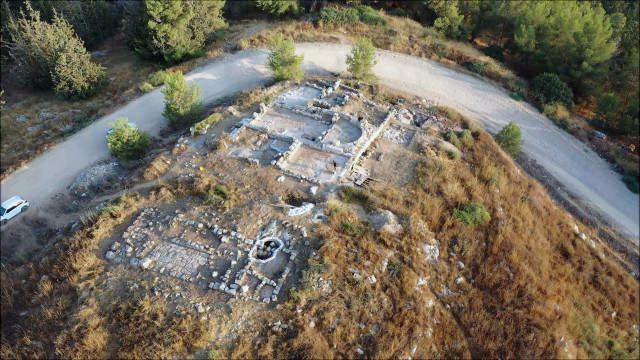Over the past month, dozens of soldiers re-uncovered a 1500-year-old nuns’ convent complex at Horbat Hani, in the low foothills east of Shoham, after a small area of the site located within a military zone was accidentally damaged by the army.Aerial view of the church complex in the military zone. (Photo credit: Idan Yunish/Israel Antiquities Authority)
The activity took place in the framework of the army educational project initiated together with the Israel Antiquities Authority: ”The Nature Defense Forces Project: Officers Take Responsibility for the Environment.”
The Byzantine convent was first excavated twenty years ago by Dr. Uzi Dahari and Dr. Yehiel Zelinger of the Israel Antiquities Authority, and it was subsequently covered up to protect it. It is now visible again, thanks to the project carried out with the soldiers.
According to Issy Kornfeld, Director of the excavation on behalf of the Israel Antiquities Authority, “Recently, a small part of the ancient ecclesiastical site was damaged in the course of army activities in the military zone. In this context, the Israel Antiquities Authority, together with the Nature Defense Forces program, initiated an educational project, whereby this impressive site was re-opened and cleaned up under the guidance of the Israel Antiquities Authority Community Educational Centre.” Kornfeld continues, “In the original excavation, two buildings were uncovered, one of which was a church paved with a colorful mosaic depicting faunal and vegetal scenes, an entrance hall, the nuns’ dormitories, hermit cells, a tower with rooms, and a crypt, an underground burial complex. The other building included a kitchen, a refectory (dining hall), and an inn for pilgrims.”
There was evidence that the convent preserved a tradition related to women. Dr. Eitan Klein, an archaeologist at the Israel Antiquities Authority, proposed that the convent at Horbat Hani, may have commemorated the burial place of the biblical Hannah, the wife of Elkanah, who was childless, and gave birth to a son, the prophet Samuel, after she vowed to dedicate him to the service of God.
According to Kornfeld, “As often in the ancient world, the convent was erected here, commemorating an ancient tradition, possibly of the burial place of Hannah, mother of the prophet Samuel.” The original excavation also uncovered a few female skeletons, possibly of women who sought to be buried in proximity to the sanctified figure of Hannah.
Guy Saly, director of the IDF Nature Defense Forces Project: ”The excavation is an example of officers taking responsibility for the environment and carrying out meaningful activity, exposing and conserving the ancient site—archaeologists together with officers and soldiers who are the citizens of tomorrow—thus enabling us to experience and connect with our country’s heritage. The soldiers and the offices enjoyed the hands-on archaeological work, and we hope that the joint activities protecting the archaeological sites will continue in the future.”
According to Eli Eskosido, Director of the Israel Antiquities Authority, “The joint IAA initiative with the IDF Nature Defense Forces Project, creates an opportunity for every soldier and army officer. The adoption of archaeological sites in army bases and military zones, and the creation of archaeological exhibitions in army bases, further consolidate the strong connection between the defense of the State of Israel, and the protection of the ancient sites and our cultural inheritance.”
The church mosaic is now partially visible, and it can be seen with advance permission from the IDF Central Command: 02-5305042.
Decorative elements in the mosaic pavement. (Photo credit: Gilad Stern/Israel Antiquities Authority)
Aerial view of the mosaic. (Photo credit: Idan Yunish/Israel Antiquities Authority)








































No comments:
Post a Comment